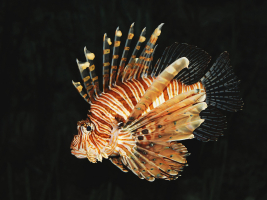Top 12 World's Most Beautiful Spiders
In today article, Toplist would like to introduce the world's most beautiful spiders. Spiders are not usually in the running for the most “beautiful animal” or ... read more...“cutest creature” in the world. In fact, many people are afraid of spiders and find it difficult to simply look at them. Spiders are frequently viewed as "ugly" pests, boring, and unimpressive beings. However, spiders are crucial to ecosystems because they control the abundance of insects and pests. Many spiders are actually incredibly attractive, with amazing colors and designs, beyond just being useful. Without further ado, here is a list of the most beautiful spiders in the world.
-
If you don't think of spiders as cute and cuddly, you've never met Sparklemuffin. Scientists have identified the cute arachnid as one of three new species of peacock spiders discovered in eastern Australia.
Male peacock spiders are less than a quarter-inch (five millimeters) long and are recognized for their vibrant colors and flamboyant courting ritual. These hues, like the brilliant red and blue of Sparklemuffin's stripes, make it easier to distinguish between species. However, many female peacock spiders resemble each other, even males.The Sparklemuffin (Maratus jactatus) is a species of the genus Maratus (peacock spiders), an Australian member of the jumping spider family. They are from the jumping spider group Salticidae. The name jactatus is Latin for rocking - derived from their signature mating rituals.
The male has a bright back, while the female has one that is cryptically colored. Similar to Maratus digitatus and Maratus calcitrans, males have vivid and distinctive color patterns. Males of the Maratus jactatus differ from those of these other species by having an opisthosomal flap that covers the opisthosomal plate. They also opened the flaps that covered their inflated opisthomal plate, displaying three distinct transverse bands of red-orange to orange-pigmented scales that were "interrupted by three bold transverse bands of unusual iridescent blue scales."
They eat small insects, which tie in with their role in the ecosystem, controlling the insect population. The control of the insects can then, in turn, help with agriculture, seeing as there are not as many insects.
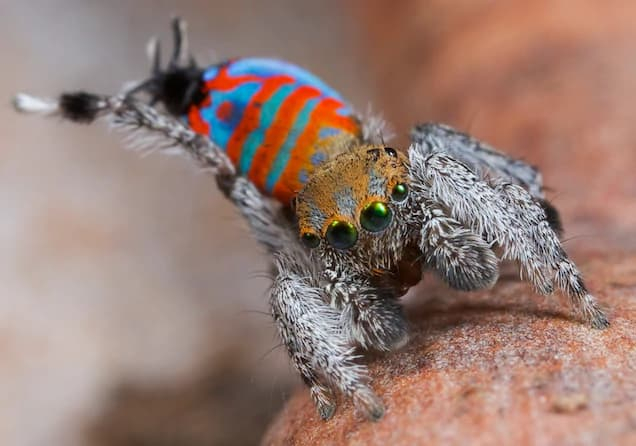
National Geographic Video by BBC -
The crab spider family includes the species Epicadus Heterogaster, which gets its name from the fact that its front legs are longer and arch forward rather than downward, giving it the appearance of a crab. They are able to "crab walk" backward and sideways as well. Crab spiders wait until insects are close enough to ambush rather than spinning webs. Epicadus heterogaster carries out this in two ways. The tiny juvenile blends in by perching on blossoms that are either white, yellow, or purple, depending on their color. Additionally, it features an abdominal protuberance that resembles flower petals. Even its jerky, sluggish movements resemble wind-tossed vegetation more than anything else.
Additionally, a mature Epicadus heterogaster can entice insects with its UV-reflective body color. This was discovered by scientists when they put sunscreen on a woman's back and observed how insects ignored it. Although it's unclear why UV reflected light draws pollination insects, it's possible that it does so because it resembles the UV color patterns or natural bright spots of flowers.
Apart from its intriguing hunting techniques and unique appearance, Epicadus Heterogaster has another fascinating aspect of its behavior: its reproductive strategy. Crab spiders have elaborate courtship rituals. A male performs a meticulously rehearsed dance to avoid being mistaken for prey when he meets a receptive female. This rhythmic dance shows his fitness and appropriateness as a partner.
The male transfers sperm to the palpal organ on his front legs during mating. This organ inseminates the female. The female may assault the male instead of mating. The male devised a clever way to avoid this threat. He intentionally inserts his abdomen near the female's jaws during copulation to increase his chances of survival if she turns aggressive.
The female crab spider carefully guards her silken egg sac after mating. She hides the egg sac on a leaf or stem. The mother will guard the spiderlings until they hatch, giving them the best chance of survival.
Epicadus Heterogaster's behavior and reproduction demonstrate arachnid diversity and complexity. Understanding these amazing creatures enhances our understanding of nature and emphasizes the necessity of protecting their habitats for future generations to enjoy.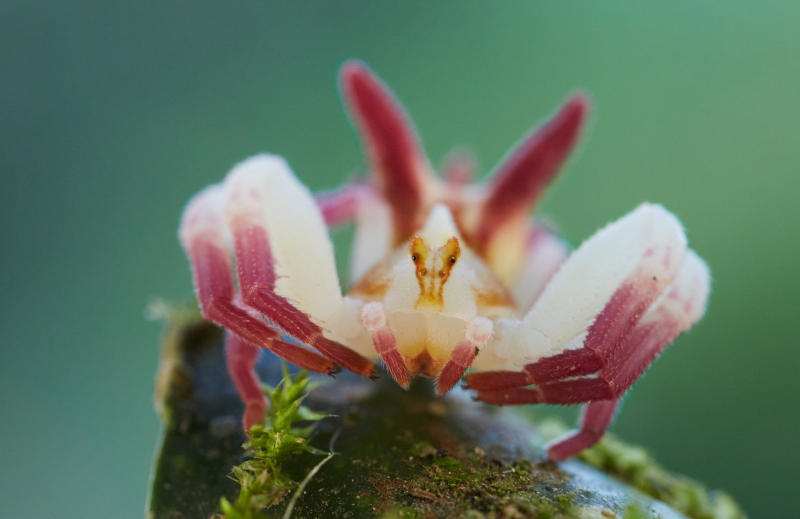
Pinterest Video by Animals -
Thwaitesia nigronodosa, a different native of Australia, can be found in Queensland's rainforests. Due to its disco ball-like butt, it has been given the names Sequined Spider or Mirror Spider, like the majority of other species of the genus Thwaitesia. Specialized cells termed guanocytes, which are crystallized versions of the digestive waste product guanine that the spider would typically excrete, are found throughout its trunk. The joined cells create a kind of feces mosaic, with the guanine reflecting light to make it appear silver, like a mirror. When concealing in a rainforest's wet undergrowth, this glittering keister is extremely useful.
The Mirror Spider has yet another protective mechanism: if disturbed or forced to leave its web rapidly, it may immediately conceal the guanocyte cells, turning its exterior color into one that resembles the muddy ground. It is thought that it does this by contracting the muscles that surround the guanocytes, however, the exact mechanism is unclear.
In addition to its remarkable mirror-like appearance and quick camouflage abilities, Thwaitesia nigronodosa possesses a unique hunting strategy. Unlike many other spiders that actively seek out prey or construct elaborate webs, the Mirror Spider is a sit-and-wait predator. It selects a suitable location amidst the rainforest foliage and remains motionless, relying on its excellent camouflage to blend in with the surroundings. When unsuspecting insects come close enough, the spider strikes with lightning speed, capturing its prey with its agile front legs. This hunting method allows the Mirror Spider to conserve energy while still securing its next meal. Its ability to swiftly change its coloration and conceal its sparkling guanocyte cells gives it a significant advantage in avoiding predators and capturing prey, making it a true marvel of adaptation in the Australian rainforests.
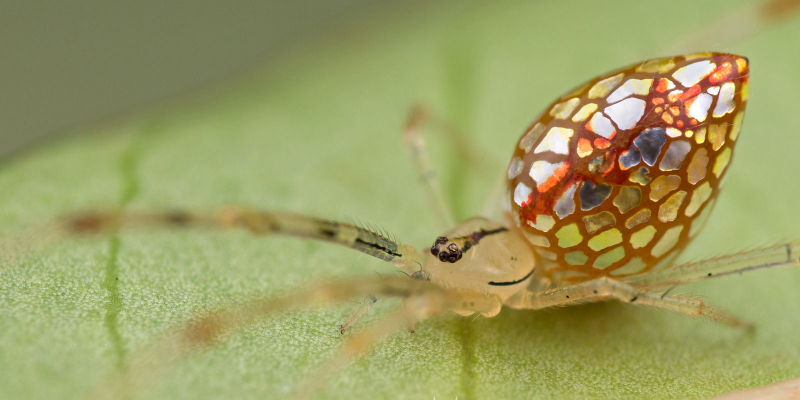
Bored Panda Video by Richland Pest & Bee Control -
The Elegant Golden Jumping Spider is known by a specific scientific name, just like the majority of spider species. The scientific name for the elegant golden jumping spider is Chrysilla lauta. From Vietnam to Burma and China, this species of spider can be found in rainforests. The elegant golden jumping spider has been known since 1887, however, it has only ever been described from male specimens.
The Elegant golden jumping spider is renowned for its stunning colors. The males, meanwhile, have an orange-red carapace and an extremely slim body. You'll see an obvious narrow bluish-white and the iridescent band just between their eyes. They differ from other jumping spider species in that it has a strong chelicera that doesn't point forward. The lengthy scutum of its opisthosoma is dark brown in color and covered in rich golden hair. Elegant golden spiders are brilliantly colored and have long, brownish-yellow legs. The Elegant golden jumping spider is quite a modest creature in terms of size.
The graceful golden jumping spider is quite a modest creature in terms of size. Although there is little information on its size, it is estimated that this species of spiders is 5mm long. This spider just doesn't measure up to others with an average size of 15 to 21 mm. Its striking and sophisticated colors are what set it apart from other jumping spider species.
We adore the exquisite golden spider's desire to flourish and live in practically any environment. Our animal companions can live in almost any environment, including habitats in savannas and grasslands as well as temperate and tropical forests. Having said that, they are frequently seen in garden foliage, on vertical surfaces like window glass and walls, as well as in meadows and woodlands. So, it wouldn't be a bad idea to investigate around these areas if you're hoping to catch one for yourself.The elegant golden jumping spiders are skilled hunters known for their impressive jumping abilities. They can capture smaller insects as well as larger ones like grasshoppers and crickets. Unlike traditional spiders, they don't use webs for hunting, relying on their quick jumps instead. In captivity, it's essential to keep them individually, as they may end up cannibalizing each other. While their primary diet consists of feeder insects like flies, crickets, roaches, and mealworms, they also consume pollen and nectar in the wild. However, certain insects like beetles and fireflies should never be fed to these spiders, as they can be harmful or even lethal. In the wild, their lifespan is around one to two years, but in captivity, they can live for two to three years, with females generally having a longer lifespan than males.
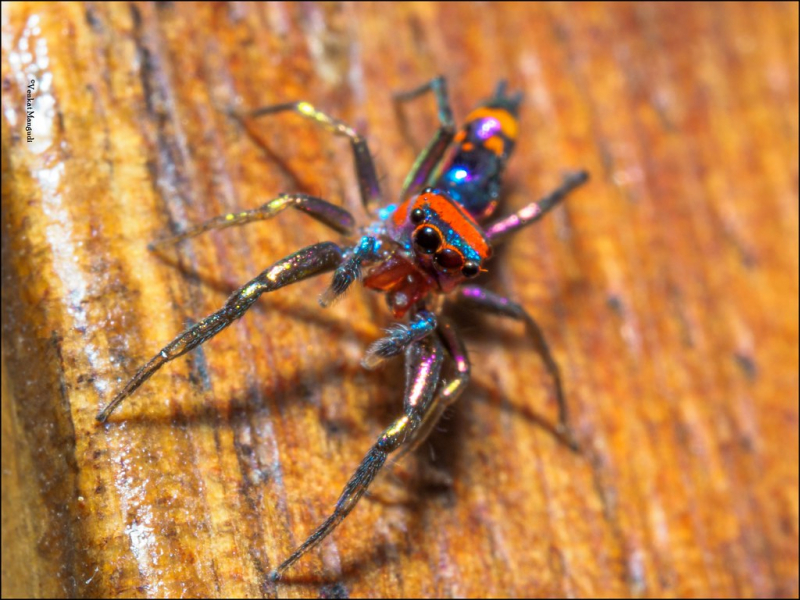
Flickr Video by Webxotic -
The Ladybird Spider gets its name from the male spider’s appearance. Males are around ¼ inch long and resemble ladybird beetles with their bright red or orange abdomen and distinct black markings (or ladybug). Although they have striking white stripes running along their legs, the rest of their body is mostly black. Ladybird spiders are entirely black in color and about a half-inch larger than males. These brightly colored spiders make silk-lined burrows and canopies that they inhabit in northern and central Europe.
The 1981 Wildlife and Countryside Act provides protection for ladybird spiders, and the British Red Data Book lists them as an endangered species due to habitat degradation. However, conservation initiatives are attempting to aid in the reintroduction of the ladybird spider to Britain. In fact, this spider increased from only fifty remaining in Britain to over six hundred in just over 10 years.
The Ladybird Spider (Eresus sandaliatus) has a fascinating mating behavior that adds to its unique characteristics. During the mating season, the male performs an intricate courtship dance to attract the female's attention. This dance involves tapping the ground with his front legs and vibrating his abdomen while producing pheromones to communicate his intentions. If the female is receptive, she responds by reciprocating the tapping and vibrations. The courtship dance is crucial for successful mating, as the female can be aggressive and attack potential mates if they do not perform the dance correctly. Once mating is successful, the female lays her eggs in a silk cocoon, which she carefully guards until the spiderlings hatch.
Due to habitat degradation and loss, the Ladybird Spider faced a severe decline in population, leading to its endangered status. However, conservation efforts and protective legislation have led to significant progress in increasing their numbers and reintroducing them to suitable habitats in northern and central Europe. The dedication to conservation initiatives has resulted in a remarkable recovery, with the population growing from mere fifty individuals in Britain to over six hundred within a decade, offering hope for the continued survival of this striking and ecologically important spider species.
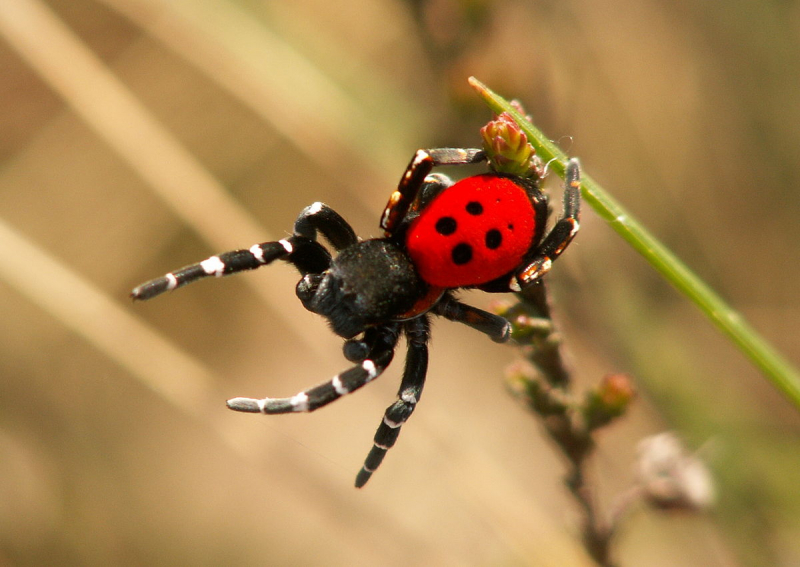
Wikipedia Video by Buglife -
The Spiny-Back Orb Weaver (Gasteracantha) is a member of the orb weaver family Araneidae. It is distributed worldwide in tropical and subtropical climates and can be found all across North and South America, as well as in some regions of Central Asia.
Male spiny-backed orb weavers are 2-3 millimeters long, compared to 5 to 9 millimeters for females. Additionally, only the females have the species' identifying six spines along the abdomen. Females with white upper abdomens typically have red or black spines, though there are other color variations. Males often have grey abdomens with white markings and many stubby projections in place of spines. Spiny-backed orb weavers like to build their webs in lightly wooded areas in regions with warm, wet climates. They prey on many garden pests, and their bite poses little threat to humans.
The unique and striking appearance of the Spiny-Back Orb Weaver extends beyond its physical characteristics. These spiders exhibit intriguing behaviors regarding web construction and hunting strategies. Unlike many other orb-weaving spiders that build large, vertical webs, the Spiny-Back Orb Weaver creates small, horizontal webs adorned with characteristic silk spines. These spines likely serve as protective structures, deterring predators or potential threats from approaching the spider while it rests at the center of its web. Furthermore, the spines may act as camouflage, helping the spider blend in with the surrounding vegetation and making it less conspicuous to passing insects.
Their hunting technique also involves an interesting tactic. When a potential prey item, such as an insect, becomes entangled in their web, the Spiny-Back Orb Weaver does not rush to capture it directly. Instead, it waits patiently and vibrates the silk threads of its web, causing the ensnared insect to become more trapped. This vibration not only reduces the chances of the prey escaping but also ensures that the web remains stable, preventing damage that could be caused by struggling prey.
Despite their relatively small size, these spiders play an essential ecological role by helping control the population of garden pests. While their bite poses little threat to humans, they are beneficial allies to gardeners, assisting in keeping insect populations in check in warm and humid regions worldwide.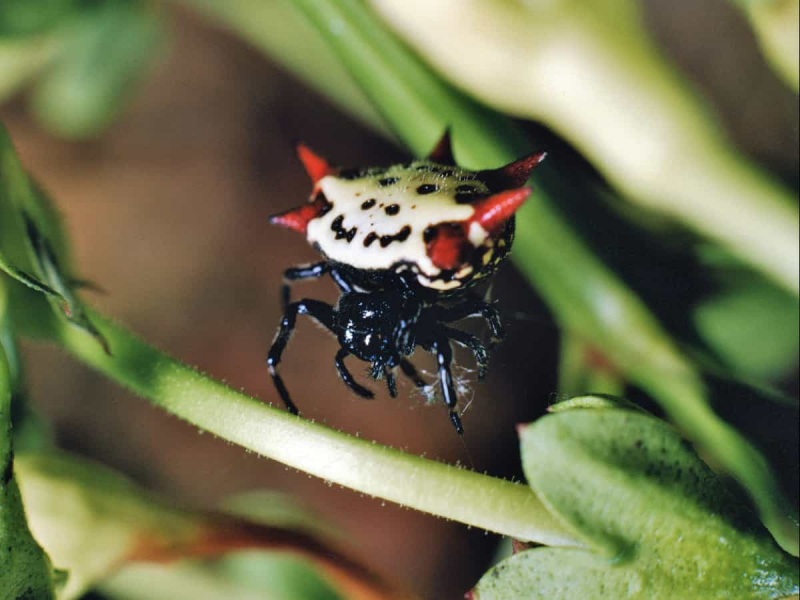
iStock.com/Weber Video by Animal Fact Files -
The Orchard Spider is a member of the long-jawed orb weaver family Tetragnathidae. These spiders are widespread throughout the eastern United States. Male orchard spiders are typically shorter than females, measuring between 3.5 and 7.5 millimeters in length. Their sides and legs are a striking shade of leaf green. Their tops are silver with black and brown stripes, while the undersides have black and yellow spots. Near the back of their abdomens, they also have brilliant yellow, orange, or red spots.
Orchard spiders frequently dangle from their horizontally arranged webs facing downward. As their name suggests, they frequently construct their webs in woody settings, including artificial ones like orchards. They feed on a variety of garden pests, and humans are not threatened by their bite. As a result, many people consider them beneficial and like to keep them around.
Intriguingly, Orchard Spiders exhibit a remarkable behavior of daily web recycling. At the end of each day, they consume their entire web, reabsorbing silk proteins and nutrients, and rebuild their webs from scratch just before dawn. This resourceful and efficient approach maximizes the utility of their silk for capturing prey. Their agility and speed in immobilizing prey by wrapping them in silk before delivering a venomous bite demonstrate their effective hunting strategies. Their attractive appearance, beneficial role, and fascinating behaviors make them valued and admired additions to natural environments and human-made settings.
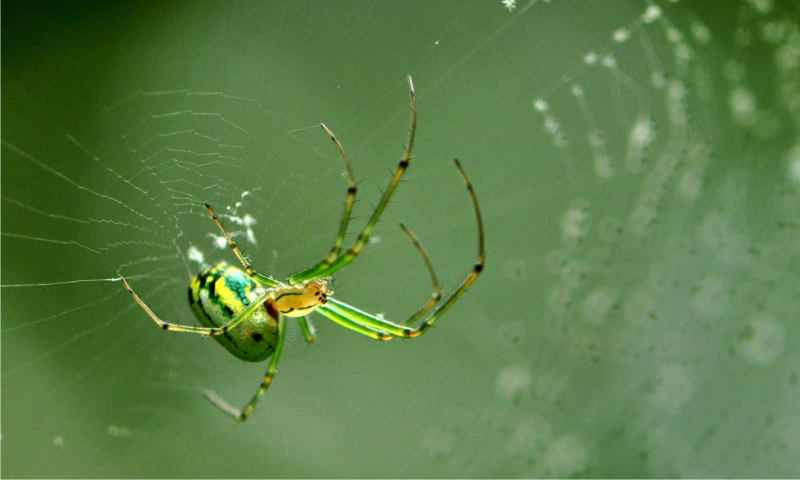
Shelly Jefferson Morton/Shutterstock.com Video by Papa Ray's Adventure Channel -
American Green Crab Spiders belong to the crab spider family Thomisidae. These spiders are widespread throughout the southeastern United States. Due to its bright green color and propensity to walk sideways like a crab, the American green crab spider earned its common name. Its bluish hue enables it to blend in with grasses and flowers, enabling it to ambush victims and evade predators.
The majority of specimens have unusually extended front legs that enable them to grip prey, and most are between 3 and 7 millimeters in length. Although they have an almost uniform green appearance, they have a tiny red line encircling the front of their abdomens. American green crab spiders hunt by keeping an eye out for insects that are coming to flowers and plants to drink nectar or collect pollen. Due to their small size, their bite is not considered medically significant and poses little threat to humans.
Female American Green Crab Spiders display intriguing maternal care behaviors. After mating, the female constructs a silken egg sac, which she attaches to vegetation near her hunting grounds. She diligently guards the egg sac, protecting it from potential threats until the spiderlings hatch. Once they emerge, the mother may continue to watch over her young for some time, ensuring their safety during their vulnerable early stages of life.
The American Green Crab Spider's adaptability, camouflage capabilities, and nurturing behavior make it a fascinating subject of study in the world of arachnids. Their small size and non-threatening nature toward humans have also earned them a place of curiosity and appreciation among nature enthusiasts and researchers alike.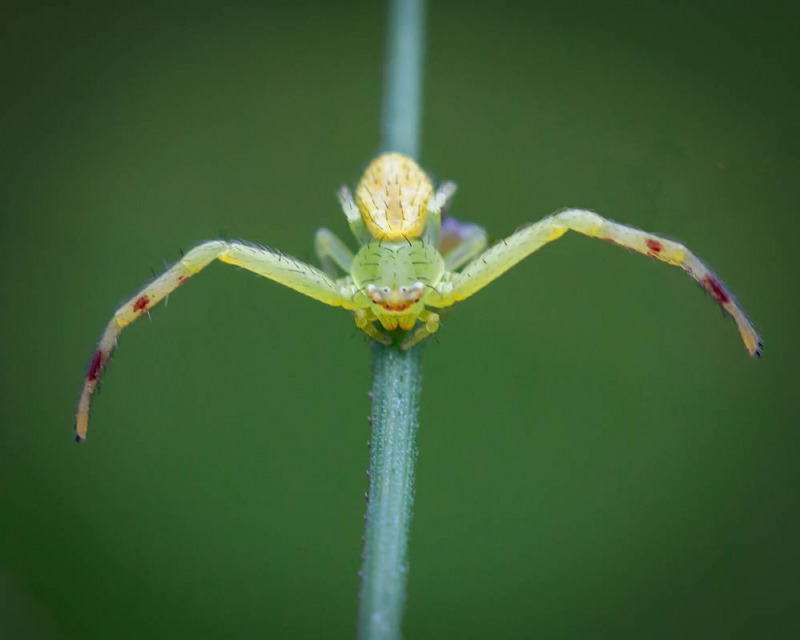
DeviantArt 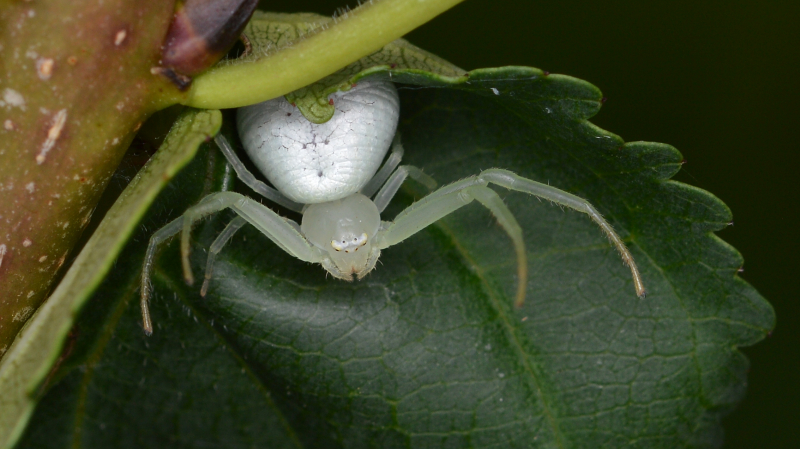
Wikimedia Commons -
A type of orb-weaving spider found in woodlands and wooded areas from the southern US to Argentina is the Golden Silk Spider (Trichonephila clavipes). In actuality, it is the sole member of the genus Trichonephila that is native to both North and South America's continents. T. clavipes weaves large, asymmetrical circular webs fastened to trees and low shrubs in wooded areas to catch small- and medium-sized flying prey, primarily insects.
The species exhibits strong sexual dimorphism in both size and color pattern, like the majority of orb-weavers. Female T. clavipes spiders can grow from 24 mm to 40 mm in length when completely developed, making them some of the biggest non-tarantula spiders in North America. They might even be the biggest species of native orb weaver in the United States. Additionally, females have very distinctive coloring, which makes the species rather simple to identify. They have a longer orange-brown abdomen with two rows of tiny white-yellow dots and a cephalothorax that is silvery white. As the spider ages, the color of its abdomen changes. The first, second, and fourth leg pairs also have black brush-like hair tufts close to the joints, and their legs are banded with dark yellow and brown coloration.
The Golden Silk Spider, often called the Banana Spider or Writing Spider, is distinguished for its size and silk. This spider's golden silk is stronger and more durable than other spiders'. Golden silk can make big, strong webs that can catch bees, wasps, and even tiny birds. Researchers are exploring commercial and industrial uses for silk's unique qualities.
The Golden Silk Spider's mating is interesting and complex. When a male approaches a female's web for mating, he methodically plucks the silk strands, generating a rhythmic pattern that calms the female and reduces her likelihood of attacking him. "Web plucking" is essential for mating Golden Silk Spiders, who can be hostile and cannibalistic if not courted. To stay safe and mate successfully, the male must approach carefully.
The Golden Silk Spider's size, color patterns, and silk production make it fascinating to study in its wooded habitat across the Americas. Its unique contributions to the world of arachnids and the potential practical uses of its silk underscore the necessity of protecting and appreciating spider diversity in nature.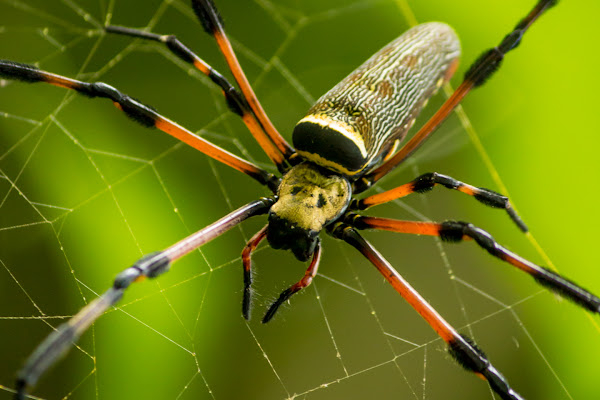
Project Noah Video by Nat Geo WILD -
The Bold Jumping Spider (Phidippus audax) is a common jumping spider in North America. P. audax, like the majority of jumping spiders, prefers to hunt in rather open settings because it actively seeks and stalks its prey rather than creating webs to catch it. They do employ webbing, but only when protecting themselves or caring for eggs. When jumping for prey or avoiding predators, they also employ spider silk as a tether.
The size and coloring of Phidippus audax vary considerably. The average body length of adult males is 8 mm, ranging from 4 to 15 mm. The body length of an adult female varies from 4 to 18 millimeters, with an average of 11 mm. Their legs and abdomen are usually covered in a pattern of dots and stripes, and they are often black. These patches are frequently orange-tinted in young spiders before turning white as they get older. However, adults frequently have yellow, orange, or red patches in various areas of Florida. The mouthparts, known as chelicerae, are either vivid, metallic green or blue.
The Bold Jumping Spider, Phidippus Audax, is not only known for its active hunting behavior and diverse size range but also for its impressive jumping abilities. These spiders possess powerful hind legs equipped with specialized muscles, allowing them to make precise and impressive leaps to capture their prey or evade potential threats. They are known for their exceptional vision, which aids in locating and stalking their target.
Additionally, Bold Jumping Spiders are not aggressive toward humans and are generally considered harmless. Their curious and inquisitive nature often makes them a favorite subject for observation and study among spider enthusiasts.
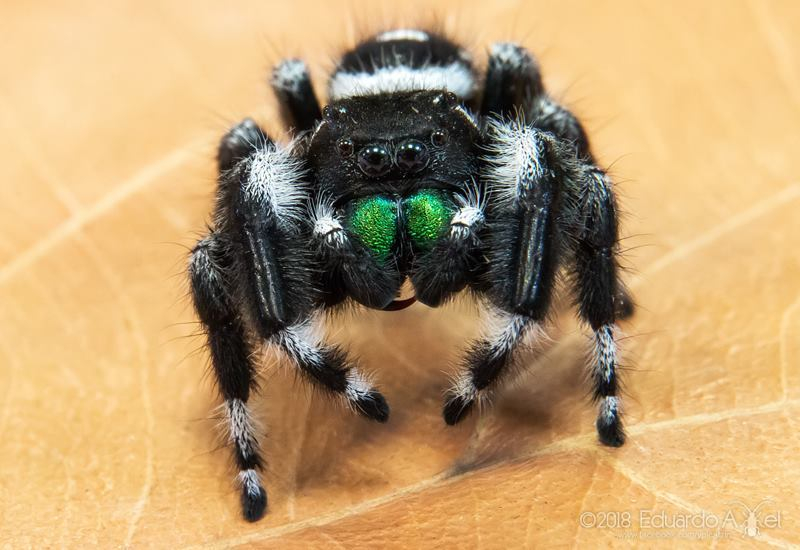
iNaturalist 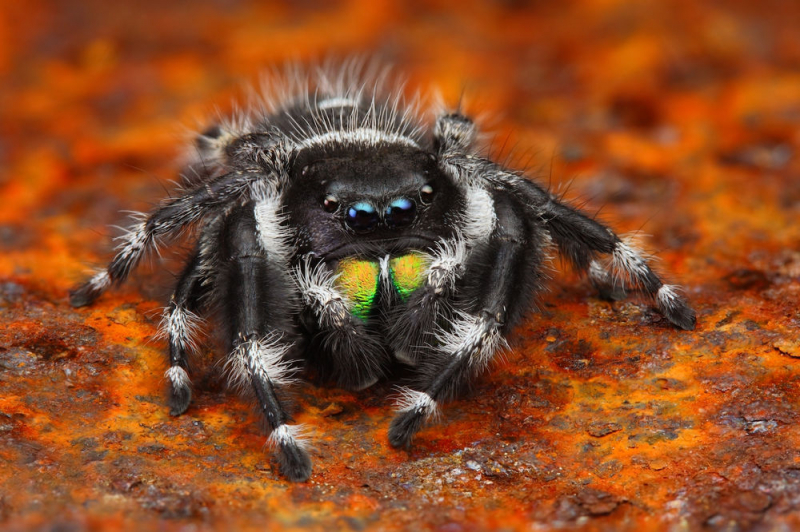
Willy's Wilderness -
The Desertas Wolf Spider, scientifically known as Hogna ingens, is a fascinating arachnid species endemic to the Desertas Islands, a small archipelago located off the coast of Madeira, Portugal. As the name suggests, it belongs to the wolf spider family (Lycosidae), which comprises a diverse group of hunting spiders known for their keen predatory skills.
The Desertas Wolf Spider is an impressive creature, with females being notably larger than males. Females can reach lengths of up to 3.5 centimeters (approximately 1.4 inches), making them one of the largest wolf spider species in the world. Their bodies are robust and covered with dark and light markings, providing effective camouflage within their rocky island habitat. It is not colorful, but it has beautiful white and grey speckles.
As ground-dwelling hunters, these spiders do not create webs to capture prey; instead, they rely on their exceptional agility and keen sense of touch to actively chase down and capture their food. The Desertas Wolf Spider primarily preys on small insects and other invertebrates found on the islands.
Unfortunately, the Desertas Wolf Spider is considered endangered due to its restricted range and potential threats to its island habitat. Conservation efforts are in place to protect and preserve this unique spider species, ensuring its survival for future generations to admire and study. As a rare and charismatic species native to a remote and ecologically sensitive location, the Desertas Wolf Spider is of particular interest to arachnologists and conservationists alike.
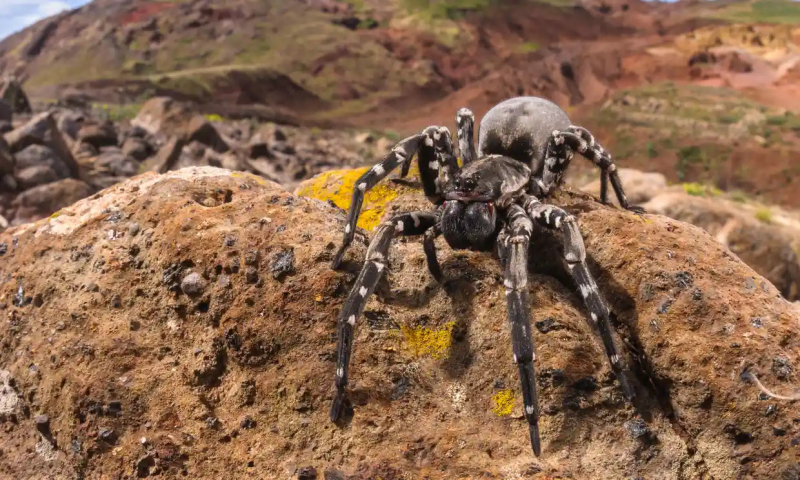
Desertas wolf spider. Photograph: Emanuele Biggi Via www.theguardian.com Video by Longleat -
The Martinique Red Tree Spider is also known as Avicularia Versicolor or the Martinique Pink Toe Tarantula. This arboreal tarantula is native to the Caribbean islands of Martinique and Dominica, where it is found in tropical rainforests and can often be seen dwelling in trees and vegetation.
As the name suggests, the spider undergoes a fascinating color change as it matures. Juvenile Martinique Red Tree Spiders typically display a vibrant blue coloration, which gradually transitions to green as they grow older. Adult females further develop unique pink fur all over their bodies, including their leg spans, adding to their captivating appearance.
Despite their size and vivid coloration, Martinique Red Tree Spiders are generally docile and rarely aggressive toward humans. Their bites are not considered dangerous, often causing minimal discomfort like a bee sting. However, as with any pet spider, handling should be done with care and respect for the spider's comfort and safety.
Being an arboreal species, the Martinique Red Tree Spider is well adapted for climbing and jumping. Females, in particular, are known for their impressive jumping abilities, capable of leaping far distances up to 30 cm (approximately 12 inches). This behavior aids them in catching prey and escaping potential threats in their natural habitat.
Like many tarantula species, the Martinique Red Tree Spider is most active at night, making them nocturnal creatures. In captivity, they thrive in well-maintained terrariums with vertical space to accommodate their climbing habits, supplemented with live insects as their primary diet.
Due to their striking appearance, relatively mild temperament, and captivating behavior, the Martinique Red Tree Spider has become a sought-after species among arachnid enthusiasts and is kept as a unique and captivating pet by many spider keepers around the world.
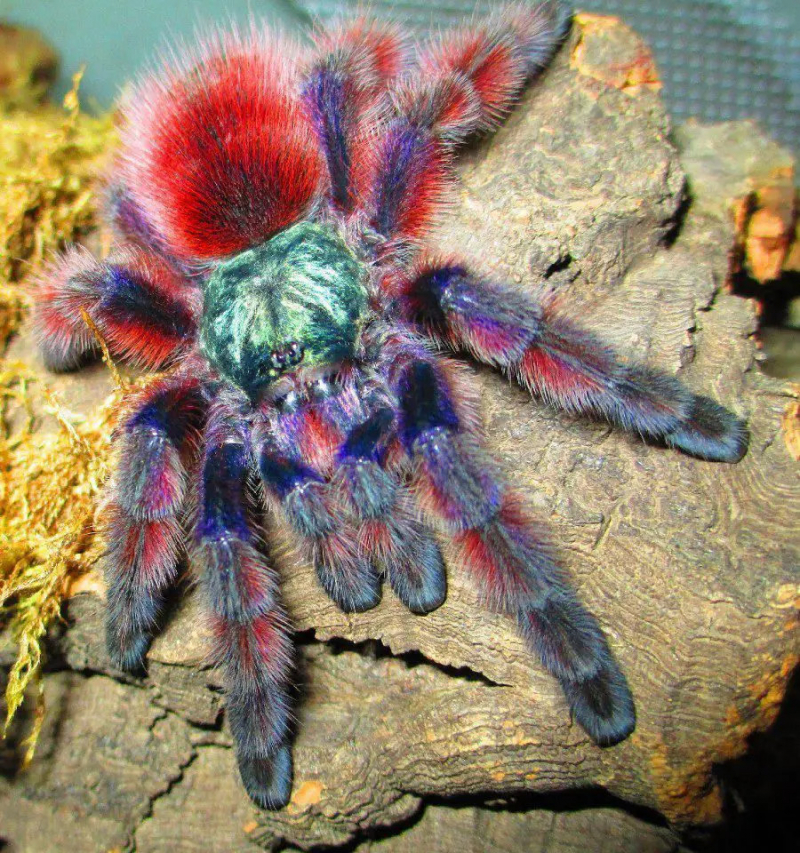
Photo on Spider Identifications Video by Tarantula Collective
































